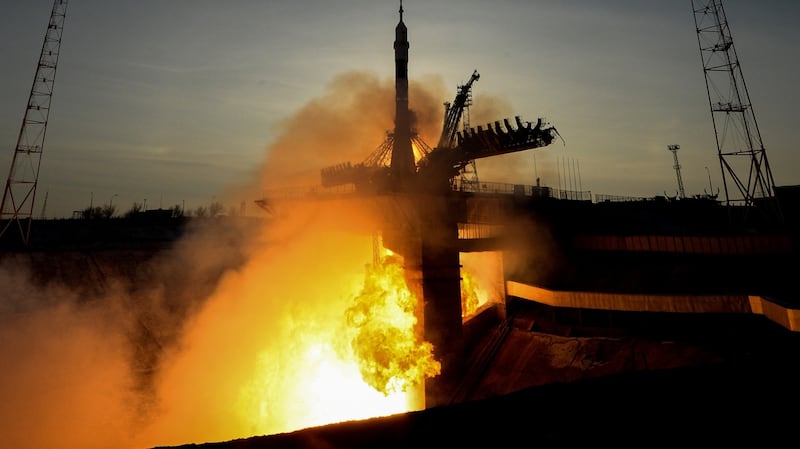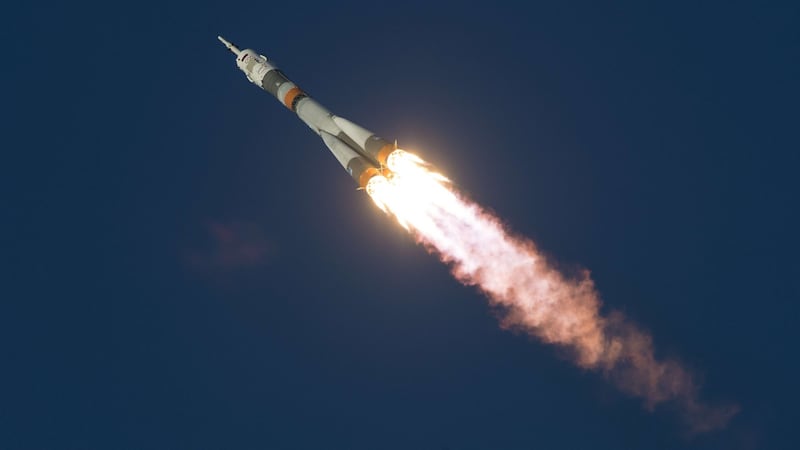Britain's first European Space Agency astronaut, Tim Peake, has blasted off on a six-month mission to the International Space Station from the Baikonur cosmodrome in Kazakhstan.
The 310-tonne Soyuz rocket launched into a clear blue sky over the Kazakh steppe at 11.03am GMT on a six-hour trip to deliver major Peake and his two crewmates to the orbiting station.
Travelling in the cramped Soyuz capsule with Peake are Nasa astronaut Tim Kopra and veteran Russian commander Yuri Malenchenko. They are arrived at the space station at 5.33pm GMT and opened the hatch to their new home two hours later.


The 26 million horsepower rocket engines burn 270 tonnes of kerosene and liquid oxygen to catch up with the space station, which circles the planet at 17,500mph, 400km above the surface.
Before take-off, Peake said farewell to his wife Rebecca and their two young sons from behind a glass screen that protects the astronauts from picking up infections ahead of their trip into space. He later waved and gave a thumbs up to his children from the bus that takes the astronauts to the launchpad.
As the crew suited up and got ready for launch, wellwishers sent Peake messages of good luck for the mission. Elton John, who released the track Rocket Man in 1972, said on Twitter: "From one Rocket Man to another, good luck @astro-timpeake with your launch and mission!"
Peake (43) was born in Chichester and worked as an army helicopter pilot and later a helicopter test pilot before being selected for the European astronaut corps in 2009.
Until his selection, the British government had a policy that opposed the funding of human space flight. His trip to the space station comes 24 years after Helen Sharman, a chemist from Sheffield, became the first Briton in space at the age of 27. She flew to the Russian Mir space station as part of a privately-funded venture.
Peake's mission, Principia, centres on dozens of scientific experiments to explore how the body adapts to space, how advanced materials form in weightless conditions, and trialling new technologies, including remote control systems for operating rovers on planetary surfaces.
Piers Sellers, a Sussex-born scientist who flew three missions as a Nasa astronaut, said: "It's wonderful to finally see an official UK astronaut go into space – something that all the rest of us have hoped for for years. I sure that Tim Peake will do a great job on station and that thousands of British kids will follow his adventure and be inspired by it. The Apollo programme did that for me."
The research Peake will carry out Peake will spend much of his 40-hour working week on science experiments. The International Space Station is the only laboratory where research can be done in a weightless environment and hundreds of experiments are ongoing or waiting to start.
To ensure astronauts are safe when in orbit, and in the future when they are sent on longer missions, researchers need to understand how space affects the brain and body.
Peake and his crewmates will experience 16 sunrises and sunsets every day, making it the perfect place to study body clocks. The research aims to find better ways to manage an astronaut’s sleep and waking hours. A mission to Mars could take 18 months. One experiment Peake will take part in will work out how much food astronauts need on such a long journey. Over the 11-day test, Peake will register what he eats and drink water laced with a heavy isotope of hydrogen, which allows scientists to see how his energy levels change.
Experiments are done on the outside too. Panels covered with lichen and hardy creatures called tardigrades have survived for months in the harsh radiation, vacuum and wildly varying temperatures of space. How they survive will help scientists understand if and where life might exist elsewhere in the universe.
– (Guardian service)











